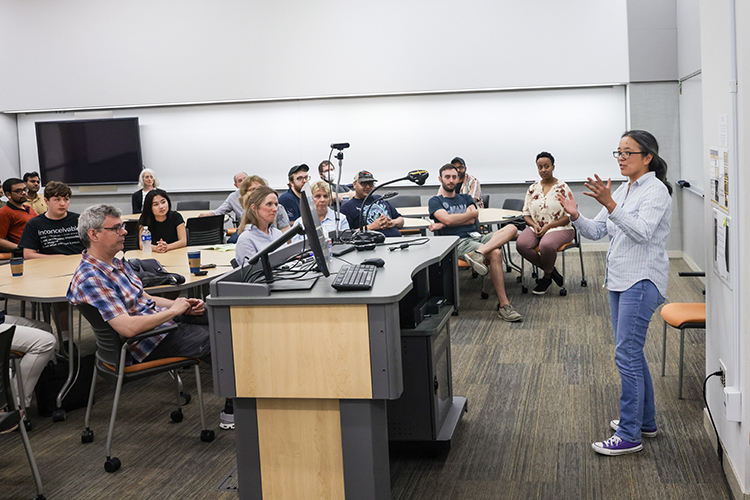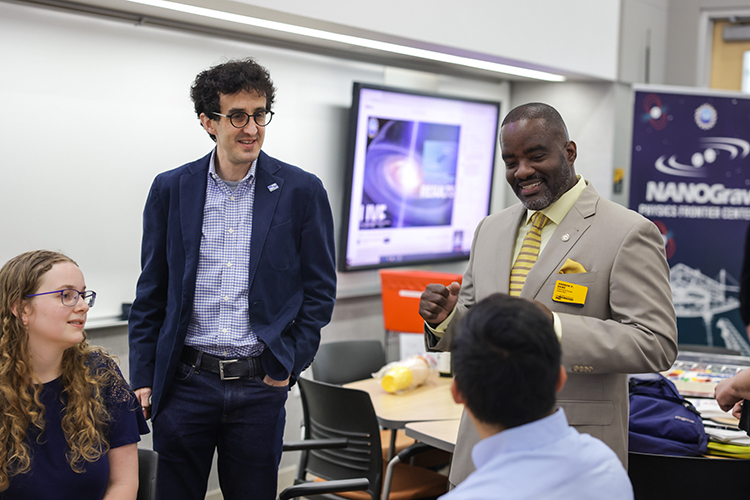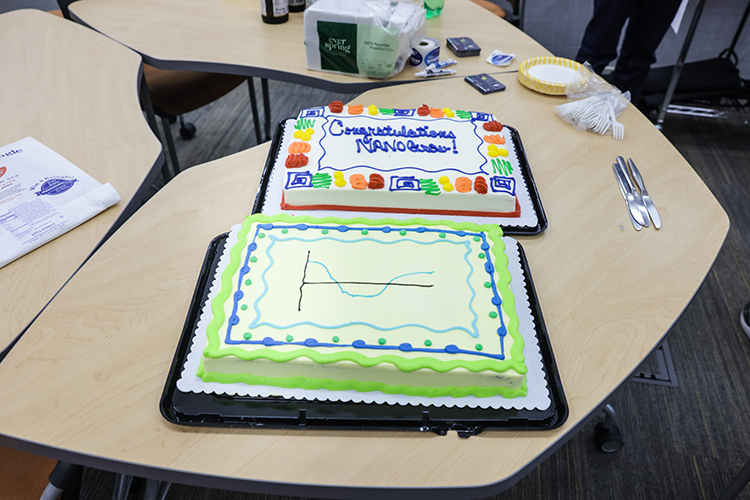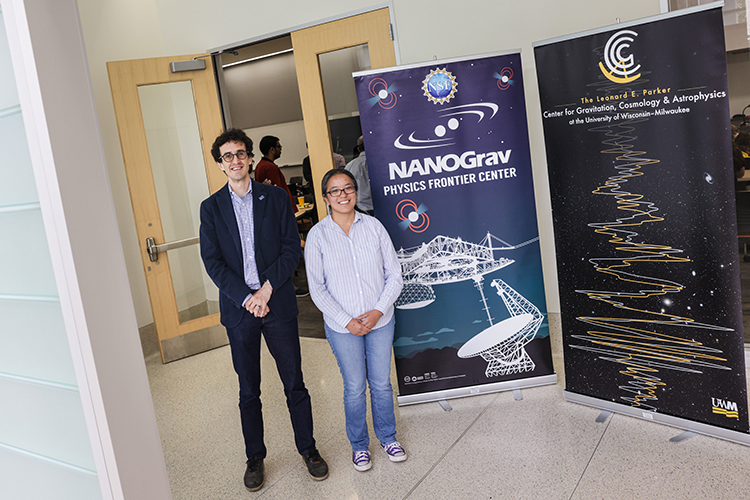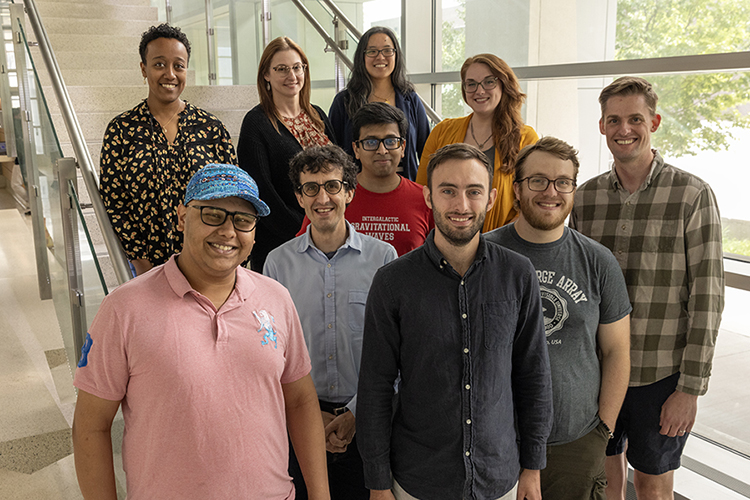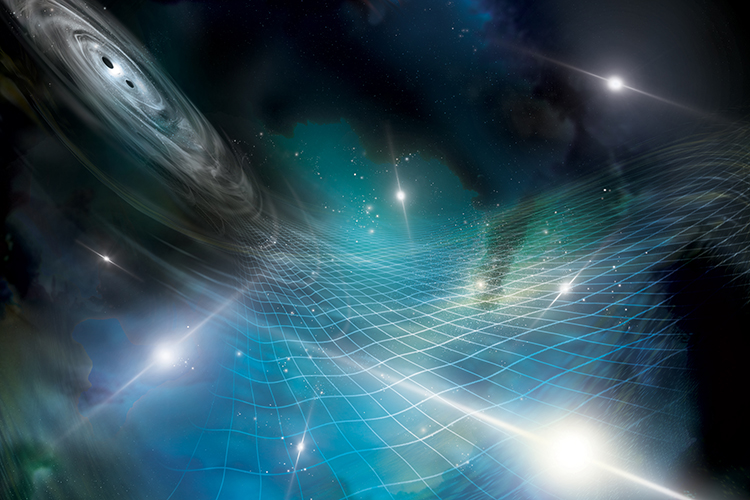It was a celebration more than 15 years in the making – and the second time UWM has had a role in the breakthrough science of gravitational waves. UWM physics students and faculty gathered to watch a livestream Thursday announcing the discovery that could tell us more than ever before about how the very early universe formed.
A collaboration of scientists in the U.S. and Canada, called the North American Nanohertz Observatory for Gravitational Waves, or NANOGrav, has compiled compelling evidence that a signal has been found for low-frequency gravitational waves that collectively generate a “background hum” across the universe. UWM has been a member of NANOGrav since its inception in 2007.
Low-frequency gravitational waves come from super-massive black hole binaries in the period just after the Big Bang when scientists theorize that the entire universe expanded in size from sub-microscopic to gargantuan in an instant. Scientists want to know more about these waves and the events that created them.
When galaxies merge – a process that’s happening all the time, all over the universe – so do the massive black holes in the centers of each. Even before the catastrophic merger, the black holes start giving out a hum of gravitational waves that starts millions of years before merging. Finally, they come together in a collision so immense that it releases a brief, but space-rattling crash of gravitational waves that warps spacetime as they spread out from the impacts.
“But it’s hard to study black holes because they don’t give off light,” said Sarah Vigeland, UWM assistant professor of physics. “Low-frequency gravitational waves will give us a way to study them without actually seeing them.”
An ingenious detection strategy
These low-frequency gravitational waves have wavelengths much longer than the size of our solar system, which means they would oscillate the span of years or decades, Vigeland said. To detect them, astronomers turned our sector of the Milky Way Galaxy into a huge gravitational-wave antenna, using a suite of exotic stars called millisecond pulsars.
Millisecond pulsars are scattered throughout the galaxy, emitting beams of radio waves while spinning hundreds of times per second. The “lighthouse-like” radio beams sweep past the Earth at extremely regular intervals and appear to “pulse” when seen from the Earth.
A passing gravitational wave change the pulses’ arrival times. So, scientists looked for timing inconsistencies by observing them with radio telescopes, which scan the sky for radio frequencies.
The problem is, the signal in an individual pulsar is very difficult to detect, Vigeland said. A massive gravitational wave moves relatively slowly, taking months, years or even decades for a single wave to rise and fall.
“The signal slowly gets louder as we add more pulsars and more data,” she said. “In the frequency we are looking at, the loudest signal is the sound of all of them together, called the gravitational wave background.”
That is what NANOGrav members believe they have detected.
Spacetime stretching and compressing
NANOGrav’s most recent dataset includes analysis of 68 millisecond pulsars, each of which is observed roughly monthly, some for more than 15 years.
This dataset contains evidence that spacetime is stretching and compressing over these long timescales, Vigeland said, which is consistent with slowly undulating gravitational waves passing through our galaxy. Scientists are describing this background as a “hum” that hasn’t been found in NANOGrav data before now.
The work was published Thursday in a set of papers in The Astrophysical Journal Letters.
In 2015, an international team of astronomers that included some at UWM found “high-frequency” gravitational waves, using ground-based facilities in the U.S. called the Laser Interferometer Gravitational-wave Observatories (LIGO).
Unlike low-frequency waves, high-frequency gravitational waves come from the collisions of small black holes and neutron stars with masses no greater than our sun and they happen on much shorter timescales. The data that each kind of wave can provide complement one another, Vigeland said.
UWM’s team
More than 190 scientists comprise NANOGrav, a Physics Frontiers Center funded by the National Science Foundation. Vigeland and David Kaplan, UWM professor of physics, lead the current UWM group: postdoctoral researchers Joe Swiggum, Abhimanyu Susobhanan and Megan Jones; doctoral students Alex McEwen, Gabriel Freedman, Shashwat Sardesai and Gabriella Agazie; and Administrative Specialist Tonia Klein.
“It’s a pretty big deal,” Agazie said. “It will eventually tell us a lot of cool stuff about the universe that we don’t yet know.”
Agazie has been studying individual pulsars to determine exactly when the pulses should be arriving on Earth. By modeling each pulsar’s characteristics, such as where it is in the sky, researchers can predict the pulse arrival time.
A native of West Virginia, Agazie became interested in astrophysics because the Green Bank Radio Telescope, one of the telescopes used in NANOGrav, is located there. Her role is the first step in the NANOGrav experiment described in the papers.
Future detections
The second is to look for interruptions in the pulse arrival times that could signal a possible gravitational wave detection.
“What a gravitational wave is doing is bending or stretching spacetime between us and the pulsar,” said Freedman, who worked on this part of the experiment. “We are trying to see if we can eke out the gravitational wave signal from all other possible sources of noise that could cause these pulse delays or advances.”
What happens next? Freedman is optimistic.
“With more time and more data, we’re able to see these signals with more clarity,” he said, “but I don’t think it will be another 15 years before we see something new. Where I see this research going is we might be able to identify individual super-massive black hole binary sources that make up this this background.”
